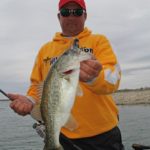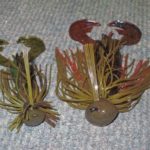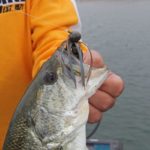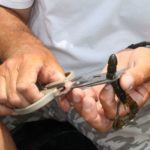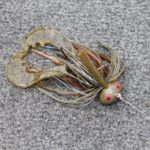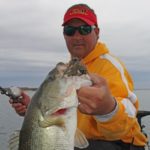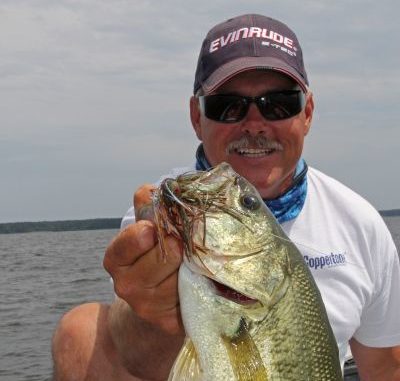
Oblong jigheads provide particular presentation benefits.
Much more than a chunky, lumbering bottom bumper, the football jig offers a diverse tool for probing deeper spots — especially those with lots of hard stuff on the bottom.
Designed to work its way across uneven surfaces with less chance of snagging, the football-head jig can indeed serve as a clunky wake-them-up tool —but it also serves well as a finesse presentation or an in-your-face reaction bait.
Toledo Bend guide Stephen Johnston recalls growing up with the opinion that a football-head was a tool for northern anglers working deep, rocky-bottom lakes. But his embracing the jig’s performance attributes and applying them to southern waters has led to much success.
“The whole purpose was that on the slick, chunk rock you could drag that jig down and it wouldn’t fall over on its side,” Johnston said. “The shape of the football-head keeps the bait from falling left or right, whereas a casting jig with a pointed head would fall over. If you throw that casting jig up on the riprap, you would wind up staying hung up more than you would with a football-head.”
Taking that thought a step further, football-heads are particularly effective when windy days challenge boat positioning and bait presentation. A heavy head that holds its ground with the right fish-taunting posture is a valuable tool when you need to keep a bait on target.
Converse angler Glenn Freeman recently employed a Booyah football jig with a green pumpkin Zoom Speed Craw trailer to win an FLW EverStart event during a blustery June weekend on Toledo.
Freeman caught his winning fish over ridges with timber in the mid-lake region, and over the three-day event he saw the fish changing their depth preference from 20 to 25 feet on day one, 15 to 20 feet on day two and, finally, 8 to 10 feet on the last day. Increasing winds likely pushed baitfish ever shallower, and the bass followed.
Although the fish adjusted their depth range each day, Freeman found them interested only in meals that slithered and hopped across the bottom. Patient and precise presentations, he said, were intrinsic to his success.
“It was a very slow presentation,” Freeman said. “They didn’t want a lot of movement. I think the weather, the wind, affected the fish. Normally, this time of year, you can move a bait fast and if they’re there, they’ll eat it.
“I didn’t work the bait fast; I worked it slowly and had a lot of confidence in it. I knew that the fish were there, so I slowed down and never once got in a hurry. I just stayed really close to the bottom.”
To help keep his football jig where it needed to be, Freeman fished it on a 7-foot, medium-heavy rod and a 7:1 reel carrying 17-pound Seaguar fluorocarbon.
The fluoro, he said, offered the dual benefit of sinking the baits quickly and providing the peace of mind he needed to fish amid the rock and wood dotting the ledges.
Kind of a drag
Notwithstanding a football-head’s proficiency at targeted presentations, Johnston said this jig has earned the right to occasionally unseat a classic coverage option — the old ball-and-chain.
Carolina rigs will never go away, but sometimes, searching broad areas is more conveniently accomplished with the more-compact and castable football jig.
“We started using football jigs in the south on soft mud bottom away from the rock, and it works the same as a Carolina rig,” Johnston said. “With a football jig, you (usually) don’t want to bounce it like a regular casting jig — you want to have a sweeping motion.
“When you drag that jig, it stirs that silt up and it would get those fish’s attention, and they’d run over there and eat it.”
Gonzales angler and Bassmaster Elite Series pro Greg Hackney concured. An accomplished jig specialist, he’d rather be throwing something with a lead or tungsten head any day of the week, and the football option benefits him in fishing’s mental game.
“For me, that jig gives me confidence that I’ll catch a big one,” he said. “It’s a big-fish lure for me. They won’t all be giants, but a bigger average. Let’s say the average fish on a Carolina rig is 1 ½- to 2 pounds, well, I feel like I can go to that same school of fish and catch a 3- or 4-pounder out of it.
“It’s the same basic jig that I’m flipping shallow cover with or casting into a brush pile, but now I can get out there and fish open water. I’ll throw it when fish are relating away from cover — flatter places, when they’re not biting the crankbait.
Johnston noted that the football-head also excels over southern rocky bottoms, from bridge riprap to jetties and break-walls, humps and ledges. If the bottom is hard and uneven, it’s a good place for a football-head.
About the only scenario in which Johnston would not feel comfortable tossing this bait would be standing timber, as the heavy head tends to turn in toward the wood, and that means lots of hang-ups.
“A football jig is also good for finding those hard places,” Hackney said. “Say you have a drop-off or a point that’s mud: You can throw that football-head and find any gravel or mussel beds out there.”
Hackney also pointed out that football-heads aren’t only a deepwater deal.
“I’ll throw this jig any time fish are on points, and it can be shallow points,” he said. “I catch them on football-heads when they’re in 2 to 3-feet when they’re up there on those points and they won’t bite a moving lure.
Creative uses
No doubt, a football-head can really make its presence known like someone pounding on your front door. But for some, maybe an elderly person living alone, a loud, frightening disturbance may actually dissuade them from opening the door: You’ll probably get a better response from a couple of light taps or a single ring of the doorbell.
Same thing goes with bass. There are times when their mean streak pulses like the Mississippi River, and they’ll attack just out of aggression. And then, there are times when every wave makes them shudder with anxiety.
When bass are tense, you can still use a football-head, but you’ll want to tweak the presentation by using a lighter head.
Bridges are a common finesse football scenario for Johnston, and he’ll go with a 3/8-ounce jig in 5 to 10 feet of water or a ½-ounce for 10 to 15 feet. Beyond that, he’ll go up to a 1-ounce, as channeled current can sweep a lighter bait off target.
In addition to head size — and even with the heavier footballs — Johnston said he’ll also create a slimmed-down package by removing the skirt, clipping off the weed guard and fitting the jig with a craw worm, Baby Brush Hog or small lizard.
“It’s a different look because the skirt gives it a bigger profile,” Johnston said. “When you take that skirt off, you’re not getting as big a profile. This is a good tool for heavily-fished areas.”
For a more direct route, you can go with a simple football-head like the Picasso Shake-E-Football that’s made with no weed guard or skirt and a flexible nickel titanium spring that holds the bait like a shaky head. Instead of threading a trailer onto the jig’s hook, you simply insert the peg into the plastic bait’s head, and then Texas-rig the hook point into the body for a specialized shaky-type presentation.
A great tool for probing deep areas where you’d have trouble presenting a light shaky head with any reasonable accuracy, a bare football-head pairs well with longer baits like a 6- or 7-inch stick bait, a slender finesse worm, a lizard or a creature bait like the full size Zoom Brush Hog.
For optimal attraction, try a thumping paddletail worm or a visually enticing ribbontail.
Contrasting these subtle approaches, Hackney won’t hesitate to put some vertical action into his football-head presentations — especially when his bite is dwindling but he knows the fish are still there.
The technique is called stroking.
Just imagine a baitfish holding near the bottom, and then suddenly darting higher into the water column. Someone’s going to eat that little maniac.
“If I’ve been fishing a group of fish by dragging it, I’ll pop it off the bottom and let it fall on a slack line,” he said. “This is a weigh-forward lure — all the weight is in the head, so you get a faster return on the fall.
“A lot of times, you can generate a reaction strike after you’ve worked the fish over pretty good with a more-conventional retrieve.”
As Hackney pointed out, the key to stroking a jig is a quick rise-quick fall motion. Simple physics dictate that the longer and/or wider an object is, the more water drag it encounters, so tightening your football head packages is essential.
FLW Tour pro and Toledo Bend fan Jim Tutt has a smart plan for this.
“When you’re stroking a football-head, you want it compact so it comes up and down quickly,” Tutt said. “I use a Strike King Rage Craw because they have long pincers, but I cut about half of the body off and I also trim the skirt down to give it a smaller profile.
“Just the head (of the craw) makes it fall faster.”
Experiment with sizes, colors, trailers and presentations and it won’t be long until you score a touchdown with the football jig.

